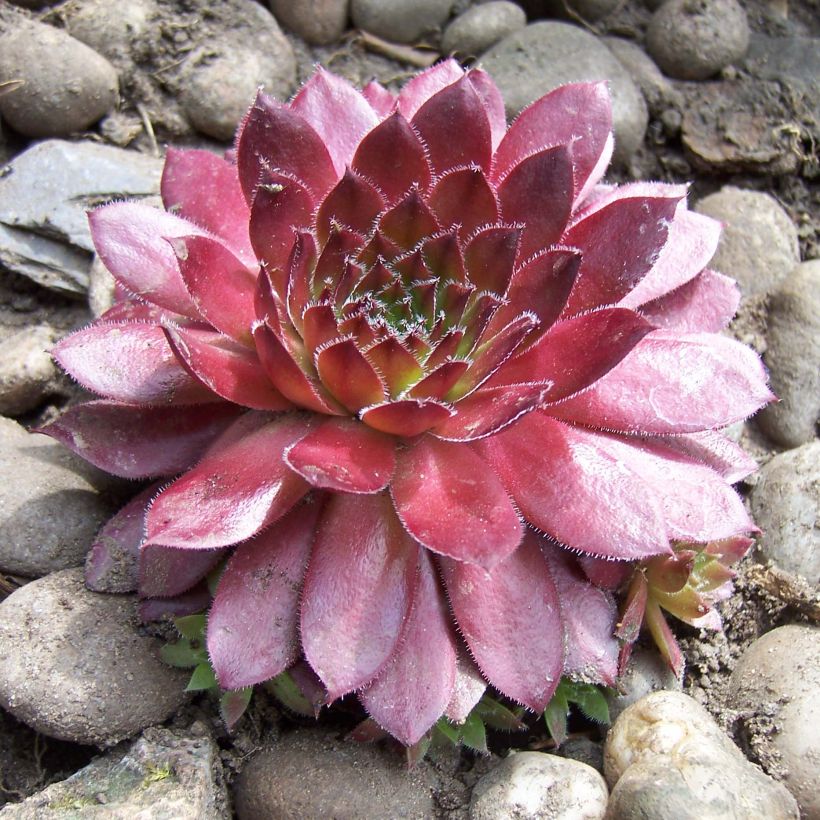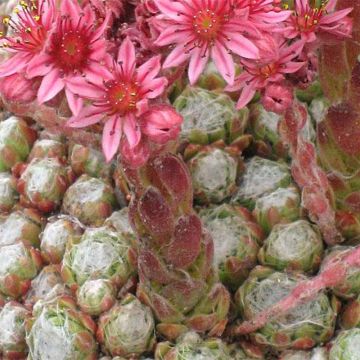

Sempervivum arachnoideum Rubin


Sempervivum arachnoideum Rubin


Sempervivum arachnoideum Rubin
Sempervivum arachnoideum Rubin
Sempervivum x arachnoideum Rubin
Cobweb Houseleek
Special offer!
Receive a €20 voucher for any order over €90 (excluding delivery costs, credit notes, and plastic-free options)!
1- Add your favorite plants to your cart.
2- Once you have reached €90, confirm your order (you can even choose the delivery date!).
3- As soon as your order is shipped, you will receive an email containing your voucher code, valid for 3 months (90 days).
Your voucher is unique and can only be used once, for any order with a minimum value of €20, excluding delivery costs.
Can be combined with other current offers, non-divisible and non-refundable.
Why not try an alternative variety in stock?
View all →This plant carries a 12 months recovery warranty
More information
We guarantee the quality of our plants for a full growing cycle, and will replace at our expense any plant that fails to recover under normal climatic and planting conditions.

Would this plant suit my garden?
Set up your Plantfit profile →
Description
With its regular shape and silky rosettes of bright purple, Sempervivum arachnoideum 'Rubin' is one of the prettiest varieties of houseleek. One beautiful summer day, like a lovely surprise, a small star-shaped flower spike of bright carmine pink emerges from the heart of the oldest rosettes. This houseleek is a small succulent plant ideal for arid and mineral areas. It requires nothing more than an open location. Without any maintenance, it miraculously survives almost without soil, in a dry, poor, siliceous environment, and relies on rainwater, even if it is scarce.
From the Crassulaceae family, the cobweb houseleek is proof that poor soil and a mineral landscape can accommodate beautiful specimens with vibrant colours. This sempervivum is quite variable in appearance. It lives on rocks or in scree, dispersing its fine seeds in crevices and clinging to the smallest fissures to slowly form small colonies of rosettes of different sizes. It has been hybridised with other species, producing beautiful varieties characterised by the presence of silky filaments on the foliage.
The hybrid cultivar 'Rubin' was selected in Germany in 1937. It was later awarded by the Royal Horticultural Society. Its juxtaposed rosettes are tightly packed, and do not exceed 10cm (4in) in all directions at maturity. Over time, it can form a creeping cushion through its stoloniferous stems, spreading up to 50 to 60cm (20 to 24in) on the ground, perfectly following the terrain. Resembling a slightly open artichoke, each perfectly organised rosette is composed of numerous fleshy, pointed leaves without petioles. The white threads, stretched between the central leaves, shine in the sun, as do the cilia that line them. The light purple colour of the leaves intensifies in summer. Flowering appears on rosettes aged 2 or 3 years, which will then disappear, having ensured the plant's perpetuity by producing several small rosettes on the periphery. The flower spikes develop in summer, formed by thick stems that bear 1 to 5 flowers with 8 to 10 petals of bright carmine pink. The roots of this perennial are thick and long. They penetrate deeply into rock crevices, ensuring a good attachment to the walls while drawing water from the depths.
Sempervivum 'Rubin' is a boon for gardens where the soil lacks thickness. It thrives where few species survive, colonising abandoned spaces. You can still enjoy this hardy perennial if your soil is poor, rather dry, stony, rocky, or even slightly chalky. It withstands temperatures below -15°C (5°F), requires no maintenance, and promises to bring life to any pile of stones, a low wall, or even a green roof. Houseleeks are easy-to-care-for succulent plants, offering flowers and foliage in various shades that create stunning compositions. Magnificent in pots, especially in low terrine-type pottery, they are irreplaceable in borders, troughs, or rockeries, alongside sedum, London pride (Saxifraga umbrosa), wall bellflowers, or Lewisia cotyledon. These miniature perennials quickly inspire the desire to multiply them. Consider choosing companions with staggered flowering times (thymes, Hertia cheirifolia, Saponaria ocymioides) and colourful foliage (Sedum spathulifolium) for a varied and joyful rock garden.
Sempervivum arachnoideum Rubin in pictures




Flowering
Foliage
Plant habit
Botanical data
Sempervivum
x arachnoideum
Rubin
Crassulaceae
Cobweb Houseleek
Alps
Other Sempervivum - Houseleek
View all →Planting and care
Sempervivum 'Rubin' likes sunny exposures and perfectly drained, moist to dry and poor soils, preferably without excess limestone. You can plant it in spring or autumn in open ground or in a pot, adding gravel or coarse sand to the planting substrate. Conversely, if you place it in a rock garden or on a wall, just give it a little compost to help it to establish itself. Afterwards, it will manage on its own. It only fears competition from taller plants, which create shade and moisture and compete with its growth.
If you wish to propagate it, simply cut a few young rosettes and replant them elsewhere, burying the roots just slightly.
Take care of it by ensuring it is not overwhelmed by taller plants, that it is not covered in dead leaves or vegetation residues, and by removing any faded inflorescences if necessary.
Planting period
Intended location
Care
Planting & care advice
This item has not been reviewed yet - be the first to leave a review about it.
Similar products
Haven't found what you were looking for?
Hardiness is the lowest winter temperature a plant can endure without suffering serious damage or even dying. However, hardiness is affected by location (a sheltered area, such as a patio), protection (winter cover) and soil type (hardiness is improved by well-drained soil).

Photo Sharing Terms & Conditions
In order to encourage gardeners to interact and share their experiences, Promesse de fleurs offers various media enabling content to be uploaded onto its Site - in particular via the ‘Photo sharing’ module.
The User agrees to refrain from:
- Posting any content that is illegal, prejudicial, insulting, racist, inciteful to hatred, revisionist, contrary to public decency, that infringes on privacy or on the privacy rights of third parties, in particular the publicity rights of persons and goods, intellectual property rights, or the right to privacy.
- Submitting content on behalf of a third party;
- Impersonate the identity of a third party and/or publish any personal information about a third party;
In general, the User undertakes to refrain from any unethical behaviour.
All Content (in particular text, comments, files, images, photos, videos, creative works, etc.), which may be subject to property or intellectual property rights, image or other private rights, shall remain the property of the User, subject to the limited rights granted by the terms of the licence granted by Promesse de fleurs as stated below. Users are at liberty to publish or not to publish such Content on the Site, notably via the ‘Photo Sharing’ facility, and accept that this Content shall be made public and freely accessible, notably on the Internet.
Users further acknowledge, undertake to have ,and guarantee that they hold all necessary rights and permissions to publish such material on the Site, in particular with regard to the legislation in force pertaining to any privacy, property, intellectual property, image, or contractual rights, or rights of any other nature. By publishing such Content on the Site, Users acknowledge accepting full liability as publishers of the Content within the meaning of the law, and grant Promesse de fleurs, free of charge, an inclusive, worldwide licence for the said Content for the entire duration of its publication, including all reproduction, representation, up/downloading, displaying, performing, transmission, and storage rights.
Users also grant permission for their name to be linked to the Content and accept that this link may not always be made available.
By engaging in posting material, Users consent to their Content becoming automatically accessible on the Internet, in particular on other sites and/or blogs and/or web pages of the Promesse de fleurs site, including in particular social pages and the Promesse de fleurs catalogue.
Users may secure the removal of entrusted content free of charge by issuing a simple request via our contact form.
The flowering period indicated on our website applies to countries and regions located in USDA zone 8 (France, the United Kingdom, Ireland, the Netherlands, etc.)
It will vary according to where you live:
- In zones 9 to 10 (Italy, Spain, Greece, etc.), flowering will occur about 2 to 4 weeks earlier.
- In zones 6 to 7 (Germany, Poland, Slovenia, and lower mountainous regions), flowering will be delayed by 2 to 3 weeks.
- In zone 5 (Central Europe, Scandinavia), blooming will be delayed by 3 to 5 weeks.
In temperate climates, pruning of spring-flowering shrubs (forsythia, spireas, etc.) should be done just after flowering.
Pruning of summer-flowering shrubs (Indian Lilac, Perovskia, etc.) can be done in winter or spring.
In cold regions as well as with frost-sensitive plants, avoid pruning too early when severe frosts may still occur.
The planting period indicated on our website applies to countries and regions located in USDA zone 8 (France, United Kingdom, Ireland, Netherlands).
It will vary according to where you live:
- In Mediterranean zones (Marseille, Madrid, Milan, etc.), autumn and winter are the best planting periods.
- In continental zones (Strasbourg, Munich, Vienna, etc.), delay planting by 2 to 3 weeks in spring and bring it forward by 2 to 4 weeks in autumn.
- In mountainous regions (the Alps, Pyrenees, Carpathians, etc.), it is best to plant in late spring (May-June) or late summer (August-September).
The harvesting period indicated on our website applies to countries and regions in USDA zone 8 (France, England, Ireland, the Netherlands).
In colder areas (Scandinavia, Poland, Austria...) fruit and vegetable harvests are likely to be delayed by 3-4 weeks.
In warmer areas (Italy, Spain, Greece, etc.), harvesting will probably take place earlier, depending on weather conditions.
The sowing periods indicated on our website apply to countries and regions within USDA Zone 8 (France, UK, Ireland, Netherlands).
In colder areas (Scandinavia, Poland, Austria...), delay any outdoor sowing by 3-4 weeks, or sow under glass.
In warmer climes (Italy, Spain, Greece, etc.), bring outdoor sowing forward by a few weeks.


































































